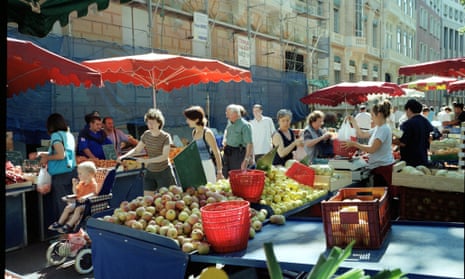A German traveller buying drinks in Lithuania would probably marvel at such a cheap round. Continuing on his tour of the Baltics, if the same person fancied a tipple in Finland he is more likely to make a joke about needing a mortgage to pay for a bottle of vodka.
Welcome to the eurozone, where the coins and notes are the same but the prices differ markedly. While its 19 member countries share a currency, they do not share the same prices for products in their respective states. The cost of living and relative purchasing power varies across each of the member states. In other words the real value of €100 varies across the currency union. The same is true in the US as illustrated here by the Tax Foundation.
The map below shows you how much €100 buys across the eurozone.
Germany and Italy are closest to the European average at €100 and €99 respectively.
Lithuania is where money travels furthest. In the newest eurozone member you pay €100 for what would cost you €142 in Germany. It’s followed by Slovakia (€137) and the other Baltic states, Latvia (€134) and Estonia (€127). Portugal is the cheapest western country in the eurozone with €100 in Germany worth about €122 in Lisbon.
On the other side of the coin, spending €100 in Luxembourg gets you the least of any of the Eurozone countries - €68’s worth - while €100 has the purchasing power of €77 in Ireland and Finland.
This can be a hard concept to understand but it basically boils down to a whole bunch of items varying in price across different countries. For example, you can probably find an espresso in Paris for €1.50. In Italy there would be riots if the price of a shot of coffee exceeded €1.
That means spending €100 in Paris would get you 66 espressos but doing the same in Rome would get you 100 (and probably a severe case of caffeine poisoning). When you apply this across a range of goods and services, you get the purchasing power of the euro in each of the countries.
Some of these basket items have been plucked apart in Eurostat’s explainer. For example, Ireland, the home of Guinness, is the most expensive place in Europe for alcohol and tobacco while Bulgaria is the cheapest. Clothes are priciest in Sweden except for footwear which is even more costly in Denmark.
To make our map we looked at purchasing power parity on actual individual consumption from Eurostat. In plainer English this measures the price of a standard basket of goods across the continent as well as making adjustments for how much spending the state does on individual households (rather than general spending such as defence and healthcare). We adjusted it so that the average of the 19 Eurozone countries was the base and that allowed us to see how much impact €100 had across the continent.

Comments (…)
Sign in or create your Guardian account to join the discussion